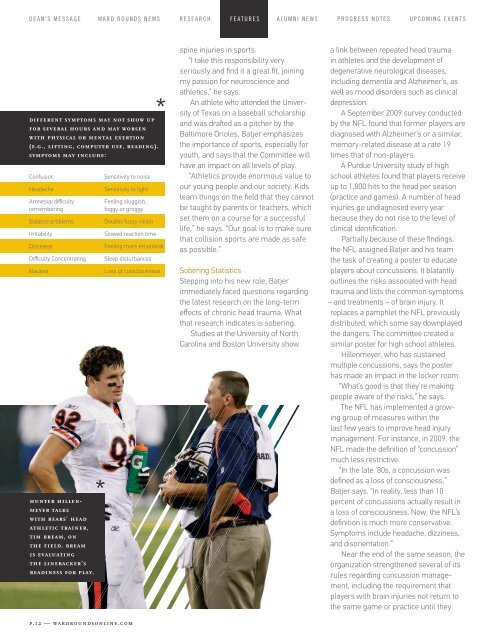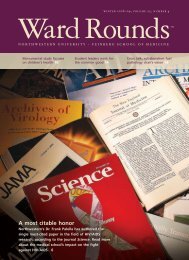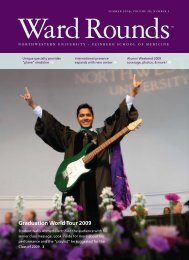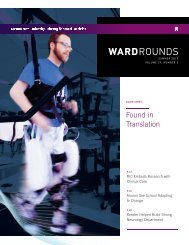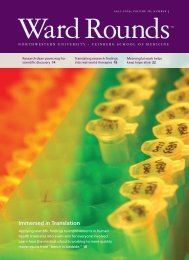Download PDF - Ward Rounds - Northwestern University
Download PDF - Ward Rounds - Northwestern University
Download PDF - Ward Rounds - Northwestern University
You also want an ePaper? Increase the reach of your titles
YUMPU automatically turns print PDFs into web optimized ePapers that Google loves.
DEAN’S MESSAGE WARD ROUNDS NEWS RESEARCH FEATURES ALUMNI NEWS PROGRESS NOTES UPCOMING EVENTS<br />
different symptoms may not show up<br />
for several hours and may worsen<br />
with physical or mental exertion<br />
(e.g., lifting, computer use, reading).<br />
symptoms may include:<br />
Confusion<br />
Headache<br />
Amnesia/diffi culty<br />
remembering<br />
Balance problems<br />
Irritability<br />
Dizziness<br />
Diffi culty Concentrating<br />
Nausea<br />
hunter hillenmeyer<br />
talks<br />
with bears’ head<br />
athletic trainer,<br />
tim bream, on<br />
the field. bream<br />
is evaluating<br />
the linebacker’s<br />
readiness for play.<br />
Sensitivity to noise<br />
Sensitivity to light<br />
Feeling sluggish,<br />
foggy or groggy<br />
Double/fuzzy vision<br />
Slowed reaction time<br />
Feeling more emotional<br />
Sleep disturbances<br />
Loss of consciousness<br />
spine injuries in sports.<br />
“I take this responsibility very<br />
seriously and fi nd it a great fi t, joining<br />
my passion for neuroscience and<br />
athletics,” he says.<br />
An athlete who attended the <strong>University</strong><br />
of Texas on a baseball scholarship<br />
and was draſt ed as a pitcher by the<br />
Baltimore Orioles, Batjer emphasizes<br />
the importance of sports, especially for<br />
youth, and says that the Committee will<br />
have an impact on all levels of play.<br />
“Athletics provide enormous value to<br />
our young people and our society. Kids<br />
learn things on the fi eld that they cannot<br />
be taught by parents or teachers, which<br />
set them on a course for a successful<br />
life,” he says. “Our goal is to make sure<br />
that collision sports are made as safe<br />
as possible.”<br />
Sobering Statistics<br />
Stepping into his new role, Batjer<br />
immediately faced questions regarding<br />
the latest research on the long-term<br />
eff ects of chronic head trauma. What<br />
that research indicates is sobering.<br />
Studies at the <strong>University</strong> of North<br />
Carolina and Boston <strong>University</strong> show<br />
a link between repeated head trauma<br />
in athletes and the development of<br />
degen erative neurological diseases,<br />
including dementia and Alzheimer’s, as<br />
well as mood disorders such as clinical<br />
depression.<br />
A September 2009 survey conducted<br />
by the NFL found that former players are<br />
diagnosed with Alzheimer’s or a similar,<br />
memory-related disease at a rate 19<br />
times that of non-players.<br />
A Purdue <strong>University</strong> study of high<br />
school athletes found that players receive<br />
up to 1,800 hits to the head per season<br />
(practice and games). A number of head<br />
injuries go undiagnosed every year<br />
because they do not rise to the level of<br />
clinical identifi cation.<br />
Partially because of these fi ndings,<br />
the NFL assigned Batjer and his team<br />
the task of creating a poster to educate<br />
players about concussions. It blatantly<br />
outlines the risks associated with head<br />
trauma and lists the common symptoms<br />
– and treatments – of brain injury. It<br />
replaces a pamphlet the NFL previously<br />
distributed, which some say downplayed<br />
the dangers. The committee created a<br />
similar poster for high school athletes.<br />
Hillenmeyer, who has sustained<br />
multiple concussions, says the poster<br />
has made an impact in the locker room.<br />
“What’s good is that they’re making<br />
people aware of the risks,” he says.<br />
The NFL has implemented a growing<br />
group of measures within the<br />
last few years to improve head injury<br />
management. For instance, in 2009, the<br />
NFL made the defi nition of “concussion”<br />
much less restrictive.<br />
“In the late ’80s, a concussion was<br />
defi ned as a loss of consciousness,”<br />
Batjer says. “In reality, less than 10<br />
percent of concussions actually result in<br />
a loss of consciousness. Now, the NFL’s<br />
defi nition is much more conservative.<br />
Symptoms include headache, dizziness,<br />
and disorientation.”<br />
Near the end of the same season, the<br />
organization strengthened several of its<br />
rules regarding concussion management,<br />
including the requirement that<br />
players with brain injuries not return to<br />
the same game or practice until they<br />
have been cleared by an independent<br />
expert. In October 2010, the NFL announced<br />
that it would suspend players,<br />
even fi rst-time off enders, for helmet-tohelmet<br />
hits.<br />
Charting a New Course<br />
While these measures have helped,<br />
much work still remains to fully understand<br />
and minimize the damage caused<br />
by severe head trauma. To that end,<br />
Batjer and Ellenbogen have formed six<br />
subcommittees to look into specifi c areas.<br />
The Subcommittee on Equipment<br />
Standards/Designs and NFL Rules<br />
will coordinate on-fi eld testing of new<br />
equipment and will work with engineers<br />
and experts from the Department of<br />
Defense, NASCAR, and the Indy 500,<br />
among others, on equipment design.<br />
The Subcommittee on Return to Play<br />
will make recommendations on returnto-play<br />
rules (currently players take a<br />
baseline cognitive test at the season’s<br />
start and cannot return aſt er an injury<br />
until they perform at the previous level)<br />
and communication about head injuries<br />
on the fi eld.<br />
A Subcommittee on Advocacy and<br />
Education will disseminate information<br />
about the known eff ects, symptoms, and<br />
treatment of concussions to players at<br />
all levels.<br />
Currently, the committee is advocating<br />
for passage of the Zach Lysedt law<br />
in all 50 states. Named for an injured high<br />
school football player, the law sets new<br />
return-to-play rules for student athletes<br />
and educates players and parents about<br />
brain and spine injuries.<br />
The Brain and Spine Injury Research<br />
subcommittee will commission novel<br />
research about equipment testing, and<br />
the relationship between impacts and<br />
concussions.<br />
Two subcommittees will focus on<br />
answering the fundamental question:<br />
Does cognitive damage depend on the<br />
severity of impact or the number of<br />
injuries?<br />
The Subcommittee on Former Players<br />
Long-Term Eff ects of Brain and Spine<br />
Injury will complete a meta-analysis of<br />
information regarding neurological func-<br />
tion in retired athletes and is considering a study that compares the cognitive function<br />
of former NFL athletes with former college players who never went pro.<br />
Finally, the Subcommittee for the Development and Management of a Prospective<br />
Database for NFL Players will create a catalog of current players’ concussion history<br />
when they entered the NFL and the results of neurological tests and images taken<br />
throughout their career. It will off er neurological testing every fi ve years aſt er<br />
retirement to those in the database to help identify and provide early treatment for<br />
cognitive issues.<br />
To gather information about impacts next season, the subcommittee will test the<br />
use of accelerometers in the helmets of at least eight teams to measure the number<br />
and amplitude of hits each player sustains. It also plans to build on research that has<br />
identifi ed a gene which may make carriers more susceptible to neurological damage<br />
and explore the use of a swab test to inform<br />
players of their possible risks.<br />
The Future of Concussion Management<br />
With all these projects underway,<br />
Batjer says he has high hopes for<br />
the eventual eradication of chronic<br />
traumatic en chephalopathy as a<br />
risk for pro-football players.<br />
“It is my sincere belief<br />
that the changes that have<br />
occurred as well as the<br />
new knowledge being<br />
gained is going to<br />
dramatically improve<br />
dr. hunt batjer, far right, and dr. richard ellenbogen, second right, co-chairs<br />
of the nfl head, neck, and spine medical committee, testify before the house<br />
judiciary committee forum on key issues related to head injuries in football.<br />
our man agement and protection of<br />
players from concussions and eliminate<br />
chronic traumatic enceph alopathy within<br />
20 years,” he says.<br />
More immediately, Batjer says<br />
teams and fans will see a reduction in<br />
the number of players willing or able to<br />
return to a game following a hard hit.<br />
“The game will change a bit as the<br />
players adapt to the culture of proper<br />
management of brain and spinal<br />
injuries and recognize that you do not<br />
play through injuries of this type, you<br />
play through injuries to soſt tissues and<br />
joints,” he explains.<br />
All of this comes as good news to<br />
athletes like Hillenmeyer, an active<br />
football player since the fourth grade.<br />
The linebacker, who plans to donate his<br />
brain to the Boston <strong>University</strong> Center for<br />
the Study of Traumatic Encephalopathy<br />
upon death, has pushed for more<br />
information about concussions aſt er<br />
educating himself about their possible<br />
long-term eff ects.<br />
“Most guys think maybe they’ll have<br />
a bum knee or a bad ankle when they’re<br />
older but, beyond that, they’ll be fi ne,” he<br />
says. “Now we’re learning there might be<br />
some long-term impact on our cognitive<br />
function, and no one can say for sure if<br />
it will happen to you. That’s scary and<br />
there are a lot of answers we still have to<br />
fi gure out.”<br />
p.12 — wardroundsonline.com<br />
ward rounds winter 2010-11 — p.13


